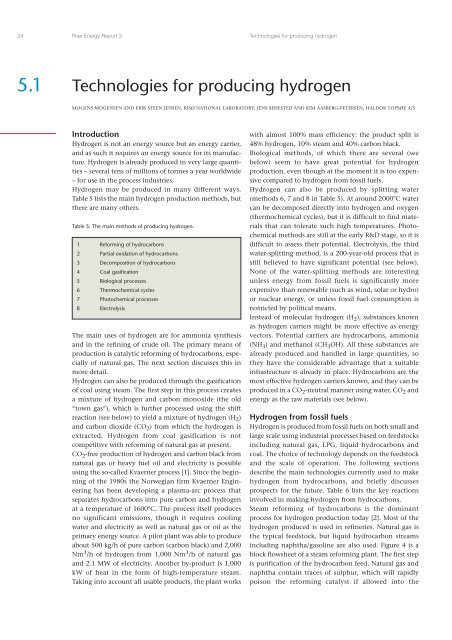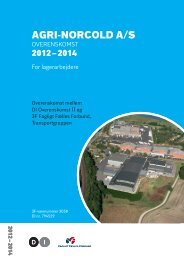Hydrogen and its competitors, 2004
Hydrogen and its competitors, 2004
Hydrogen and its competitors, 2004
Create successful ePaper yourself
Turn your PDF publications into a flip-book with our unique Google optimized e-Paper software.
24Risø Energy Report 3Technologies for producing hydrogen5.1Technologies for producing hydrogenMOGENS MOGENSEN AND ERIK STEEN JENSEN, RISØ NATIONAL LABORATORY; JENS SEHESTED AND KIM AASBERG-PETERSEN, HALDOR TOPSØE A/SIntroduction<strong>Hydrogen</strong> is not an energy source but an energy carrier,<strong>and</strong> as such it requires an energy source for <strong>its</strong> manufacture.<strong>Hydrogen</strong> is already produced in very large quantities– several tens of millions of tonnes a year worldwide– for use in the process industries.<strong>Hydrogen</strong> may be produced in many different ways.Table 5 lists the main hydrogen production methods, butthere are many others.Table 5: The main methods of producing hydrogen.1 Reforming of hydrocarbons2 Partial oxidation of hydrocarbons3 Decomposition of hydrocarbons4 Coal gasification5 Biological processes6 Thermochemical cycles7 Photochemical processes8 ElectrolysisThe main uses of hydrogen are for ammonia synthesis<strong>and</strong> in the refining of crude oil. The primary means ofproduction is catalytic reforming of hydrocarbons, especiallyof natural gas. The next section discusses this inmore detail.<strong>Hydrogen</strong> can also be produced through the gasificationof coal using steam. The first step in this process createsa mixture of hydrogen <strong>and</strong> carbon monoxide (the old“town gas”), which is further processed using the shiftreaction (see below) to yield a mixture of hydrogen (H 2 )<strong>and</strong> carbon dioxide (CO 2 ) from which the hydrogen isextracted. <strong>Hydrogen</strong> from coal gasification is notcompetitive with reforming of natural gas at present.CO 2 -free production of hydrogen <strong>and</strong> carbon black fromnatural gas or heavy fuel oil <strong>and</strong> electricity is possibleusing the so-called Kvaerner process [1]. Since the beginningof the 1980s the Norwegian firm Kvaerner Engineeringhas been developing a plasma-arc process thatseparates hydrocarbons into pure carbon <strong>and</strong> hydrogenat a temperature of 1600°C. The process <strong>its</strong>elf producesno significant emissions, though it requires coolingwater <strong>and</strong> electricity as well as natural gas or oil as theprimary energy source. A pilot plant was able to produceabout 500 kg/h of pure carbon (carbon black) <strong>and</strong> 2,000Nm 3 /h of hydrogen from 1,000 Nm 3 /h of natural gas<strong>and</strong> 2.1 MW of electricity. Another by-product is 1,000kW of heat in the form of high-temperature steam.Taking into account all usable products, the plant workswith almost 100% mass efficiency: the product split is48% hydrogen, 10% steam <strong>and</strong> 40% carbon black.Biological methods, of which there are several (seebelow) seem to have great potential for hydrogenproduction, even though at the moment it is too expensivecompared to hydrogen from fossil fuels.<strong>Hydrogen</strong> can also be produced by splitting water(methods 6, 7 <strong>and</strong> 8 in Table 5). At around 2000°C watercan be decomposed directly into hydrogen <strong>and</strong> oxygen(thermochemical cycles), but it is difficult to find materialsthat can tolerate such high temperatures. Photochemicalmethods are still at the early R&D stage, so it isdifficult to assess their potential. Electrolysis, the thirdwater-splitting method, is a 200-year-old process that isstill believed to have significant potential (see below).None of the water-splitting methods are interestingunless energy from fossil fuels is significantly moreexpensive than renewable (such as wind, solar or hydro)or nuclear energy, or unless fossil fuel consumption isrestricted by political means.Instead of molecular hydrogen (H 2 ), substances knownas hydrogen carriers might be more effective as energyvectors. Potential carriers are hydrocarbons, ammonia(NH 3 ) <strong>and</strong> methanol (CH 3 OH). All these substances arealready produced <strong>and</strong> h<strong>and</strong>led in large quantities, sothey have the considerable advantage that a suitableinfrastructure is already in place. Hydrocarbons are themost effective hydrogen carriers known, <strong>and</strong> they can beproduced in a CO 2 -neutral manner using water, CO 2 <strong>and</strong>energy as the raw materials (see below).<strong>Hydrogen</strong> from fossil fuels<strong>Hydrogen</strong> is produced from fossil fuels on both small <strong>and</strong>large scale using industrial processes based on feedstocksincluding natural gas, LPG, liquid hydrocarbons <strong>and</strong>coal. The choice of technology depends on the feedstock<strong>and</strong> the scale of operation. The following sectionsdescribe the main technologies currently used to makehydrogen from hydrocarbons, <strong>and</strong> briefly discussesprospects for the future. Table 6 lists the key reactionsinvolved in making hydrogen from hydrocarbons.Steam reforming of hydrocarbons is the dominantprocess for hydrogen production today [2]. Most of thehydrogen produced is used in refineries. Natural gas isthe typical feedstock, but liquid hydrocarbon streamsincluding naphtha/gasoline are also used. Figure 4 is ablock flowsheet of a steam reforming plant. The first stepis purification of the hydrocarbon feed. Natural gas <strong>and</strong>naphtha contain traces of sulphur, which will rapidlypoison the reforming catalyst if allowed into the
















